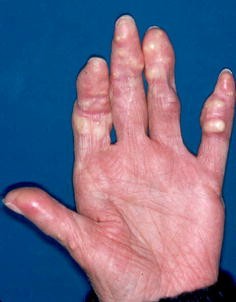How do you get calcinosis cutis ?
CALCINOSIS CUTIS :
Calcinosis cutis is a type of calcinosis where in calcium deposits form in the skin . A variety of factor can results in this condition . The most common source is dystrophic calification which occurs in soft tissue as a response to injury . In addition calcinosis is seen in limited cutaneous systemic sclerosis , also known as CREST syndrome . In dogs and is thought to occur after a traumatic injury .
WHAT ARE THE SIGNS AND SYMPTOMS OF CALCINOSIS CUTIS ?
The signs and symptoms of calcinosis cutis vary according to the underlying cause . In many cases, the lesions gradually develop and are often symptomless . The lesions usually appear as firm , whitish /yellowish papules , plaques or nodules on the surface of the skin . A solitary lesion may develop, although multiple lesions are more common . Lesion may become tender and ulcerate , discharging chalk - like creamy material consisting mainly of calcium phosphate with a small amount of calcium carbonate . Fingertips lwsion may be painful , while lesions at other sites may restrict joint mobility and limit movement due to stiffening of the skin . In severe casescutaneous gangrene may occur .
WHAT ARE THE CAUSES OF CALCINOSIS CUTIS ?
Calcinosis cutis is classified into 4 major types :
1. DYSTROPHIC CALCINOSIS CUTIS :
Dystrophic calcinosis cutis occurs in an area where there is damaged , inflamed , neoplastic or necrotic skin. Tissue damage may be from mechanical, chemical , infectious or other factors . Normal serum calcium and phosphate levels exist . Conditions that can dystrophic calcinosis cutis may include :
- trauma
- acne
- varicose veins
- infections
- tumours
- connective tissue disease
- panniculitis
- inherited diseases of connective tissue
- become very painful
- ulcerate and recurrent infections occur
- cause functional impairment




Comments
Post a Comment